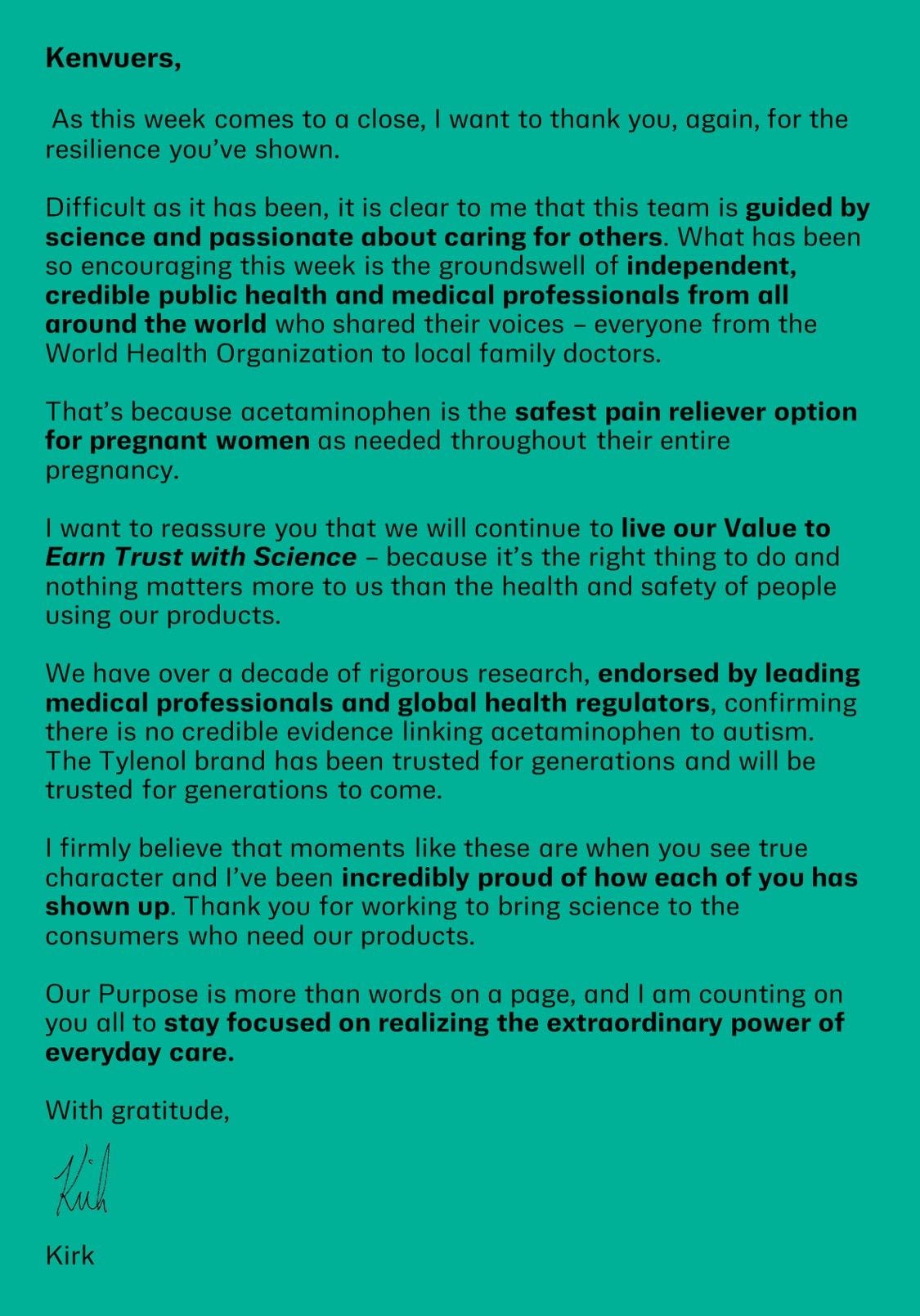Leadership in a VUCA World
Some considerations on the Tylenol-gate
Leadership in a VUCA World: Responding with Integrity, Clarity and Conviction
Leadership today no longer operates in conditions of stability or predictability. Instead, it takes place within a volatile, uncertain, complex, and ambiguous environment—what is often described using the acronym VUCA. This framework, borrowed from military thinking, is not a metaphor. It is a description of daily operating reality for organisations facing sudden reputation risk, evolving consumer trust, and widespread misinformation.
Recently, a Director and Interim CEO at Kenvue (previously Johnson & Johnson Consumer Health) shared a letter with employees following public speculation around the safety of acetaminophen, commonly known as Tylenol. The comments in question were not grounded in evidence and spread rapidly, triggering consumer concern. The leadership response did not attack, deny, or retreat. Instead, it centred the conversation on facts, values, and purpose.
This newsletter examines how that letter exemplifies the kind of leadership necessary in a VUCA world, why it is effective, what it represents, and what it teaches us about the demands on FMCG leadership today.
Responding to Volatility with Emotional Grounding
Volatility requires speed and steadiness at once. In emotionally charged moments, the first job of a leader is to stabilise. This doesn’t mean solving everything immediately. It means setting the tone so others don’t lose their own bearings.
The letter begins:
“As this week comes to a close, I want to thank you, again, for the resilience you’ve shown.”
This choice of opening matters. It does not lead with the issue. It leads with the people. That’s leadership recognising that teams need to feel seen before they can absorb direction. It’s also a quiet reminder that calm is contagious.
The letter continues:
“It is clear to me that this team is guided by science and passionate about caring for others.”
This kind of language reframes crisis as character-defining. When things are volatile, the leader’s role is not to fight the storm, but to affirm what remains constant.
Dealing with Uncertainty by Holding to What Is Known
Uncertainty is different from volatility. It’s not about speed; it’s about not knowing which direction is correct. In these conditions, leaders must clarify what is known, acknowledge what is not, and resist the urge to speculate.
This is handled with precision:
“We have over a decade of rigorous research... confirming there is no credible evidence linking acetaminophen to autism.”
This is a firm, factual boundary. It’s also an example of how to use institutional credibility without overstepping. The letter avoids overclaiming. Instead, it reminds the audience what the data currently shows and who stands behind it: namely, the World Health Organisation and medical professionals across various disciplines.
But most importantly, the statement is tethered to the company’s purpose:
“We will continue to live our Value to Earn Trust with Science – because it’s the right thing to do and nothing matters more to us than the health and safety of people using our products.”
In times of uncertainty, data can be debated. But values provide a stable ground. That is what leadership must anchor to when facts alone cannot resolve doubt.
Managing Complexity Through Narrative Clarity
Complexity in leadership doesn’t just mean difficult; it means interconnected. An issue affecting one product can simultaneously impact regulators, media coverage, employee morale, and consumer trust. A leader cannot resolve this kind of issue with detail alone. They must simplify the message without distorting the truth.
The letter does this by repeating a few key ideas, clearly and consistently:
“That’s because acetaminophen is the safest pain reliever option for pregnant women as needed throughout their entire pregnancy.”
“The Tylenol brand has been trusted for generations and will be trusted for generations to come.”
These are not new facts. But their value lies in their clarity. They strip complexity down to what matters most: safety, scientific support, and trust built over time.
Still, complexity also requires coordination. The letter focuses mainly on internal reassurance. A stronger signal that the organisation is working with external partners—public health authorities, regulators, scientists— would have shown how the company is managing the issue as part of a wider system, not just an isolated event.
Leading Through Ambiguity with Purpose and Consistency
Ambiguity is the most complex condition of all. It occurs when the available information is contradictory or difficult to interpret. People are left unsure of what to believe. In these moments, the leader’s role is to offer a consistent voice.
Not to eliminate ambiguity, which is a long-term effort, but to navigate it effectively.
This is where the letter is strongest. It doesn’t try to over-explain. It doesn’t try to win an argument. It simply restates the company’s orientation:
“I want to reassure you that we will continue to live our Value to Earn Trust with Science.”
“Stay focused on realising the extraordinary power of everyday care.”
These aren’t claims. They are commitments. When outcomes are unclear, people need to know where the company stands. That is the proper function of leadership in ambiguity: not to have every answer, but to show what will guide future decisions.
Why VUCA Requires a Different Kind of Leadership
What this letter demonstrates is not just good messaging. It’s a shift in how leadership works in VUCA environments. Traditional leadership was built on control, certainty, and authority. It is assumed that stability is the norm and that the leader’s job is to maintain it.
But today, disruption is the norm. What matters is not how firmly one holds authority, but how clearly one can communicate values, share responsibility, and model adaptability.
This example shows that:
Leadership must remain emotionally resilient in the face of volatility.
Leadership must be intellectually honest in uncertainty.
Leadership must create clarity in a complex message.
Leadership must demonstrate consistency of values in ambiguous situations.
This is not a new skillset. It is a new mindset. One where the leader doesn’t perform certainty but instead models conviction. One where the goal is not to win the moment but to protect the long arc of trust.
In an era when misinformation spreads faster than facts and public voices can sow doubt even in long-standing scientific consensus, leadership is not about shouting louder. It’s about staying principled, staying present, and staying connected to the people who carry the work forward each day.
As the letter reminds its audience:
“Thank you for working to bring science to the consumers who need our products.”
Leadership in a VUCA world is not a strategy; it is a mindset.
It is a responsibility.
And in moments like these, that responsibility is not abstract; it is deeply human.




